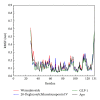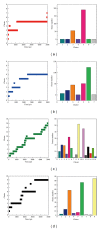Design of glucagon-like Peptide-1 receptor agonist for diabetes mellitus from traditional chinese medicine
- PMID: 24891870
- PMCID: PMC4033432
- DOI: 10.1155/2014/385120
Design of glucagon-like Peptide-1 receptor agonist for diabetes mellitus from traditional chinese medicine
Abstract
Glucagon-like peptide-1 (GLP-1) is a promising target for diabetes mellitus (DM) therapy and reduces the occurrence of diabetes due to obesity. However, GLP-1 will be hydrolyzed soon by the enzyme dipeptidyl peptidase-4 (DPP-4). We tried to design small molecular drugs for GLP-1 receptor agonist from the world's largest traditional Chinese medicine (TCM) Database@Taiwan. According to docking results of virtual screening, we selected 2 TCM compounds, wenyujinoside and 28-deglucosylchikusetsusaponin IV, for further molecular dynamics (MD) simulation. GLP-1 was assigned as the control compound. Based on the results of root mean square deviation (RMSD), solvent accessible surface (SAS), mean square deviation (MSD), Gyrate, total energy, root mean square fluctuation (RMSF), matrices of smallest distance of residues, database of secondary structure assignment (DSSP), cluster analysis, and distance of H-bond, we concluded that all the 3 compounds could bind and activate GLP-1 receptor by computational simulation. Wenyujinoside and 28-deglucosylchikusetsusaponin IV were the TCM compounds that could be GLP-1 receptor agonists.
Figures













Similar articles
-
Discovery of Novel DPP-IV Inhibitors as Potential Candidates for the Treatment of Type 2 Diabetes mellitus Predicted by 3D QSAR Pharmacophore Models, Molecular Docking and de novo Evolution.Molecules. 2019 Aug 7;24(16):2870. doi: 10.3390/molecules24162870. Molecules. 2019. PMID: 31394858 Free PMC article.
-
Cardiovascular Actions and Clinical Outcomes With Glucagon-Like Peptide-1 Receptor Agonists and Dipeptidyl Peptidase-4 Inhibitors.Circulation. 2017 Aug 29;136(9):849-870. doi: 10.1161/CIRCULATIONAHA.117.028136. Circulation. 2017. PMID: 28847797 Review.
-
Glycaemic efficacy of glucagon-like peptide-1 receptor agonists and dipeptidyl peptidase-4 inhibitors as add-on therapy to metformin in subjects with type 2 diabetes-a review and meta analysis.Diabetes Obes Metab. 2012 Aug;14(8):762-7. doi: 10.1111/j.1463-1326.2012.01603.x. Epub 2012 Apr 24. Diabetes Obes Metab. 2012. PMID: 22471248 Review.
-
Risk of heart failure hospitalization among users of dipeptidyl peptidase-4 inhibitors compared to glucagon-like peptide-1 receptor agonists.Cardiovasc Diabetol. 2018 Jul 17;17(1):102. doi: 10.1186/s12933-018-0746-4. Cardiovasc Diabetol. 2018. PMID: 30016946 Free PMC article.
-
Computational screening and molecular docking of compounds from Traditional Chinese Medicine (TCM) by targeting DNA topoisomerase I to design potential anticancer drugs.PLoS One. 2024 Sep 12;19(9):e0310364. doi: 10.1371/journal.pone.0310364. eCollection 2024. PLoS One. 2024. PMID: 39264927 Free PMC article.
Cited by
-
Potential Role of Phytochemicals as Glucagon-like Peptide 1 Receptor (GLP-1R) Agonists in the Treatment of Diabetes Mellitus.Pharmaceuticals (Basel). 2024 Jun 5;17(6):736. doi: 10.3390/ph17060736. Pharmaceuticals (Basel). 2024. PMID: 38931402 Free PMC article. Review.
References
-
- Finan B, Ma T, Ottaway N, et al. Unimolecular dual incretins maximize metabolic benefits in rodents, monkeys, and humans. Science Translational Medicine. 2013;5(209)209ra151 - PubMed
-
- Randle PJ, Garland PB, Hales CN, Newsholme EA. The glucose fatty-acid cycle. Its role in insulin sensitivity and the metabolic disturbances of diabetes mellitus. The Lancet. 1963;281(7285):785–789. - PubMed
-
- Sun HY, Ke FD, Wen JS. Prevalence of diabetes among men and women in China. The New England Journal of Medicine. 2010;362(25):2425–2426. - PubMed
-
- Nerup J, Platz P, Ortved Andersen O. HL A antigens and diabetes mellitus. The Lancet. 1974;2(7885):864–866. - PubMed
-
- Bottazzo GF, Florin Christensen A, Doniach D. Islet cell antibodies in diabetes mellitus with autoimmune polyendocrine deficiencies. The Lancet. 1974;2(7892):1279–1283. - PubMed
LinkOut - more resources
Full Text Sources
Other Literature Sources
Miscellaneous

